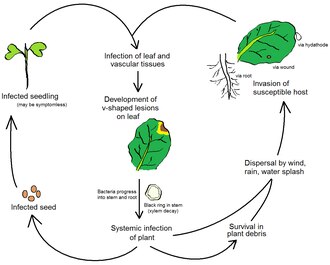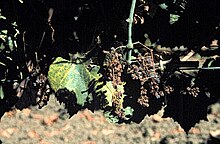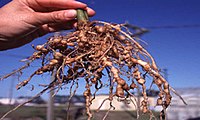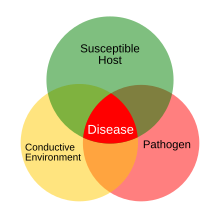Plant pathology: Difference between revisions
→Plant pathogens: gloss and wl caption, repos img by relevant text |
→Fungi: also asco, maybe a basidio image wd be better |
||
| Line 22: | Line 22: | ||
Biotrophic fungal pathogens colonize living plant tissue and obtain nutrients from living host cells. [[Necrotroph]]ic fungal pathogens infect and kill host tissue and extract nutrients from the dead host cells. Significant fungal plant pathogens include:{{citation needed|date=July 2017}} |
Biotrophic fungal pathogens colonize living plant tissue and obtain nutrients from living host cells. [[Necrotroph]]ic fungal pathogens infect and kill host tissue and extract nutrients from the dead host cells. Significant fungal plant pathogens include:{{citation needed|date=July 2017}} |
||
[[File:Rice blast.jpg|thumb|upright|[[Rice blast]], caused by a necrotrophic fungus]] |
[[File:Rice blast.jpg|thumb|upright|[[Rice blast]], caused by a necrotrophic Ascomycete fungus]] |
||
==== Ascomycetes ==== |
==== Ascomycetes ==== |
||
Revision as of 11:40, 19 December 2023
This article needs additional citations for verification. (December 2023) |

Plant pathology or phytopathology is the scientific study of diseases in plants caused by pathogens (infectious organisms) and environmental conditions (physiological factors).[1] Organisms that cause infectious disease include fungi, oomycetes, bacteria, viruses, viroids, virus-like organisms, phytoplasmas, protozoa, nematodes and parasitic plants.[2] Not included are ectoparasites like insects, mites, vertebrate, or other pests that affect plant health by eating plant tissues and causing injury that may admit plant pathogens. Plant pathology also involves the study of pathogen identification, disease etiology, disease cycles, economic impact, plant disease epidemiology, plant disease resistance, how plant diseases affect humans and animals, pathosystem genetics, and management of plant diseases.
Plant pathogens
In most pathosystems, virulence is dependent on hydrolases and proteins that degrade the cell wall produced by pathogens. The vast majority of such proteins act on pectins (for example, pectinesterase, pectate lyase, and pectinases). For microbes the cell wall polysaccharides are both a food source and a barrier to be overcome. Many pathogens grow opportunistically when the host breaks down its own cell walls, most often during fruit ripening.[3]
Fungi

Most phytopathogenic fungi are Ascomycetes or Basidiomycetes. They reproduce both sexually and asexually via the production of spores and other structures. Spores may be spread long distances by air or water, or they may be soil borne. Many soil inhabiting fungi are capable of living saprotrophically, carrying out the part of their life cycle in the soil. These are facultative saprotrophs. Fungal diseases may be controlled through the use of fungicides and other agriculture practices. However, new races of fungi often evolve that are resistant to various fungicides. Biotrophic fungal pathogens colonize living plant tissue and obtain nutrients from living host cells. Necrotrophic fungal pathogens infect and kill host tissue and extract nutrients from the dead host cells. Significant fungal plant pathogens include:[citation needed]

Ascomycetes
- Fusarium spp. (Fusarium wilt disease)
- Thielaviopsis spp. (canker rot, black root rot, Thielaviopsis root rot)
- Verticillium spp.
- Magnaporthe grisea (rice blast)
- Sclerotinia sclerotiorum (cottony rot)
Basidiomycetes
- Ustilago spp. (smuts) smut of barley
- Rhizoctonia spp.
- Phakospora pachyrhizi (soybean rust)
- Puccinia spp. (severe rusts of cereals and grasses)
- Armillaria spp. (honey fungus species, virulent pathogens of trees)
Fungus-like organisms
Oomycetes
The oomycetes are fungus-like organisms.[4] They include some of the most destructive plant pathogens, such as the causal agents of potato late blight[4] root rot,[5] and sudden oak death.[6][7]
Despite not being closely related to the fungi, the oomycetes have developed similar infection strategies, using effector proteins to turn off a plant's defenses.[8]
Phytomyxea
Some slime molds in Phytomyxea cause important diseases, including clubroot in cabbage and its relatives and powdery scab in potatoes. These are caused by species of Plasmodiophora and Spongospora, respectively.[citation needed]
Bacteria

Most bacteria associated with plants are saprotrophic and do no harm to the plant itself. However, a small number, around 100 known species, cause disease, especiallyl in subtropical and tropical regions of the world.[9][page needed]
Most plant pathogenic bacteria are bacilli. Erwinia uses cell wall–degrading enzymes to cause soft rot. Agrobacterium changes the level of auxins to cause tumours with phytohormones.
Significant bacterial plant pathogens include:
- Burkholderia[10]
- Pseudomonadota
- Xanthomonas spp.
- Pseudomonas spp.
- Pseudomonas syringae pv. tomato causes tomato plants to produce less fruit, and it "continues to adapt to the tomato by minimizing its recognition by the tomato immune system."[11]
Mollicutes

Phytoplasma and Spiroplasma are obligate intracellular parasites, bacteria that lack cell walls and, like the mycoplasmas, which are human pathogens, they belong to the class Mollicutes. Their cells are extremely small, 1 to 2 micrometres across. They tend to have small genomes (roughly between 0.5 and 2 Mb). They are normally transmitted by leafhoppers (cicadellids) and psyllids, both sap-sucking insect vectors. These inject the bacteria into the plant's phloem, where it reproduces.[12]

Viruses, viroids and virus-like organisms
There are many types of plant viruses, and some are asymptomatic or latent. Under normal circumstances, plant viruses cause only a loss of crop yield. Therefore, it is not economically viable to try to control them, the exception being when they infect perennial species, such as fruit trees.[citation needed]
Most plant viruses have small, single-stranded RNA genomes. However some plant viruses also have double stranded RNA or single or double stranded DNA genomes. These genomes may encode only three or four proteins: a replicase, a coat protein, a movement protein, in order to allow cell to cell movement through plasmodesmata, and sometimes a protein that allows transmission by a vector. Plant viruses can have several more proteins and employ many different molecular translation methods.[citation needed]
Plant viruses are generally transmitted from plant to plant by a vector, but mechanical and seed transmission also occur. Vector transmission is often by an insect (for example, aphids), but some fungi, nematodes, and protozoa have been shown to be viral vectors. In many cases, the insect and virus are specific for virus transmission such as the beet leafhopper that transmits the curly top virus causing disease in several crop plants.[13] One example is mosaic disease of tobacco where leaves are dwarfed and the chlorophyll of the leaves is destroyed. Another example is Bunchy top of banana, where the plant is dwarfed, and the upper leaves form a tight rosette.[citation needed]
Nematodes

Nematodes are small, multicellular, wormlike animals. Many live freely in the soil, but there are some species that parasitize plant roots. They are a problem in tropical and subtropical regions of the world, where they may infect crops. Potato cyst nematodes (Globodera pallida and G. rostochiensis) are widely distributed in Europe and North and South America and cause $300 million worth of damage in Europe every year. Root knot nematodes have quite a large host range, they parasitize plant root systems and thus directly affect the uptake of water and nutrients needed for normal plant growth and reproduction,[14] whereas cyst nematodes tend to be able to infect only a few species. Nematodes are able to cause radical changes in root cells in order to facilitate their lifestyle. There are also beneficial nematodes that can be used as a biological control for crop-destroying pests. A promising example is the effectiveness of the nematode Steinernema rarium PAM25 against the Drosophila suzuki, a type of fruit fly.[15]
Protozoa
A few plant diseases are caused by protozoa such as Phytomonas, a kinetoplastid.[16] They are transmitted as durable zoospores that may be able to survive in a resting state in the soil for many years. Further, they can transmit plant viruses. When the motile zoospores come into contact with a root hair they produce a plasmodium which invades the roots.[citation needed]
Parasitic plants
Parasitic plants such as dodder can act as a conduit for the transmission of viruses or virus-like agents from a host plant to a plant that is not typically a host, or for an agent that is not graft-transmissible.[citation needed]
Common pathogenic infection methods
To colonize a plant, pathogens have specific pathogenicity factors, of five main types: uses of cell wall–degrading enzymes, toxins, effector proteins, phytohormones, and exopolysaccharides.
- Cell wall-degrading enzymes: These are used to break down the plant cell wall in order to release the nutrients inside and include esterases, glycosyl hydrolases, lyases and oxidoreductases.[17]
- Toxins: These can be non-host-specific, which damage all plants, or host-specific, which cause damage only on a host plant.
- Effector proteins: These can be secreted into the extracellular environment or directly into the host cell, often via the Type three secretion system. Some effectors are known to suppress host defense processes. This can include: reducing the plants internal signaling mechanisms or reduction of phytochemicals production.[18] Bacteria, fungus and oomycetes are known for this function.[4][19]
- Spores: Spores of phytopathogenic fungi can be a source of infection on host plants. Spores first adhere to the cuticular layer on leaves and stems of host plant. In order for this to happen, the infectious spore must be transported from the pathogen source. This occurs via wind, water, or vectors such as insects and humans. When favourable conditions are present, the spore will produce a modified hyphae called a germ tube. This germ tube later forms a bulge called an appressorium, which forms melanized cell walls to build up turgor pressure. Once enough turgor pressure is accumulated the appressorium asserts pressure against the cuticular layer in the form of a hardened penetration peg. This process is also aided by the secretion of cell wall degrading enzymes from the appressorium. Once the penetration peg enters the host tissue it develops a specialized hyphae called a haustorium. Based on the pathogens life cycle, this haustorium can invade and feed neighboring cells intracellularly or exist intercellularly within a host.[20]
Physiological plant disorders
Some abiotic disorders can be confused with pathogen-induced disorders. Abiotic causes include natural processes such as drought, frost, snow and hail; flooding and poor drainage; nutrient deficiency; deposition of mineral salts such as sodium chloride and gypsum; windburn and breakage by storms; and wildfires. Similar disorders (usually classed as abiotic) can be caused by human intervention, resulting in soil compaction, pollution of air and soil, salinization caused by irrigation and road salting, over-application of herbicides, clumsy handling (e.g. lawnmower damage to trees), and vandalism.[citation needed]

Epidemiology
Epidemiology: The study of factors affecting the outbreak and spread of infectious diseases.[21]

A disease pyramid best captures the elements involved with plant diseases. This pyramid uses the disease triangle as a foundation, consisting of elements such as: host, pathogen and environment. In addition to these three elements, humans and time add the remaining elements to create a disease tetrahedron.
History: Plant disease epidemics that are historically known based on tremendous losses:
- Irish potato late blight[citation needed]
- Dutch elm disease[citation needed]
- Chestnut blight in North America[citation needed]
Factors affecting epidemics:
Host: Resistance or susceptibility level, age, and genetics.
Pathogen: Amount of inoculum, genetics, and type of reproduction
Disease resistance
Plant disease resistance is the ability of a plant to prevent and terminate infections from plant pathogens.
Structures that help plants prevent disease are: cuticular layer, cell walls and stomata guard cells. These act as a barrier to prevent pathogens from entering the plant host. Once diseases have overcome these barriers, plant receptors initiate signaling pathways to create molecules to compete against the foreign molecules. These pathways are influenced and triggered by genes within the host plant and are susceptible to being manipulated by genetic breeding to create varieties of plants that are resistant to destructive pathogens.[22]
Among defense mechanisms, chemical deterrence of pest settling and feeding, like the induction of defensive compounds, may be a key strategy for reducing herbivore damage.[23]
Management
Before control measures can be taken, the pathogen must be detected. Ancient methods of leaf examination and breaking open plant material by hand are now augmented by newer technologies. These include molecular pathology assays such as polymerase chain reaction (PCR), RT-PCR and loop-mediated isothermal amplification (LAMP).[24] Although PCR can detect multiple molecular targets in a single solution there are limits.[24] Bertolini et al 2001, Ito et al 2002 and Ragozzino et al 2004 developed PCR methods for multiplexing six or seven plant pathogen molecular products and Persson et al 2005 for multiplexing four with RT-PCR.[24] More extensive molecular diagnosis requires PCR arrays.[24] The primary detection method used worldwide is enzyme linked immunosorbent assay.[25]
Domestic quarantine
A diseased patch of vegetation or individual plants can be isolated from other, healthy growth. Specimens may be destroyed or relocated into a greenhouse for treatment or study.[citation needed]
Port and border inspection and quarantine
Another option is to avoid the introduction of harmful nonnative organisms by controlling all human traffic and activity (e.g., the Australian Quarantine and Inspection Service), although legislation and enforcement are crucial in order to ensure lasting effectiveness. Today's volume of global trade is providing—and will continue to provide—unprecedented opportunities for the introduction of plant pests.[McC 1] In the United States, even to get a better estimate of the number of such introductions, and thus the need to impose port and border quarantine and inspection, would require a substantial increase in inspections.[McC 2] In Australia a similar shortcoming of understanding has a different origin: Port inspections are not very useful because inspectors know too little about taxonomy. There are often pests that the Australian Government has prioritised as harmful to be kept out of the country, but which have near taxonomic relatives that confuse the issue. And inspectors also run into the opposite - harmless natives, or undiscovered natives, or just-discovered natives they need not bother with but which are easy to confuse with their outlawed foreign family members.[BH 1]
X-ray and electron-beam/E-beam irradiation of food has been trialed as a quarantine treatment for fruit commodities originating from Hawaii. The US FDA (Food and Drug Administration), USDA APHIS (Animal and Plant Health Inspection Service), producers, and consumers were all accepting of the results - more thorough pest eradication and lesser taste degradation than heat treatment.[26]
The International Plant Protection Convention (IPPC) anticipates that molecular diagnostics for inspections will continue to improve.[27] Between 2020 and 2030, IPPC expects continued technological improvement to lower costs and improve performance, albeit not for less developed countries unless funding changes.[27]
Cultural
Farming in some societies is kept on a small scale, tended by peoples whose culture includes farming traditions going back to ancient times. (An example of such traditions would be lifelong training in techniques of plot terracing, weather anticipation and response, fertilization, grafting, seed care, and dedicated gardening.) Plants that are intently monitored often benefit from not only active external protection but also a greater overall vigor. While primitive in the sense of being the most labor-intensive solution by far, where practical or necessary it is more than adequate.[citation needed]
Plant resistance
Sophisticated agricultural developments now allow growers to choose from among systematically cross-bred species to ensure the greatest hardiness in their crops, as suited for a particular region's pathological profile. Breeding practices have been perfected over centuries, but with the advent of genetic manipulation even finer control of a crop's immunity traits is possible. The engineering of food plants may be less rewarding, however, as higher output is frequently offset by popular suspicion and negative opinion about this "tampering" with nature.
Chemical
Many natural and synthetic compounds can be employed to combat the above threats. This method works by directly eliminating disease-causing organisms or curbing their spread; however, it has been shown to have too broad an effect, typically, to be good for the local ecosystem. From an economic standpoint, all but the simplest natural additives may disqualify a product from "organic" status, potentially reducing the value of the yield.
Biological
Crop rotation is a traditional and sometimes effective means of preventing a parasitic population from becoming well-established. For example, protection against infection by Agrobacterium tumefaciens, which causes gall diseases in many plants, by dipping cuttings in suspensions of Agrobacterium radiobacter before inserting them in the ground to take root. Other means to undermine parasites without attacking them directly may exist.[citation needed]
Integrated
The use of two or more of these methods in combination offers a higher chance of effectiveness.[citation needed]
Economic impact
Plant diseases cause major economic losses for farmers worldwide. Across large regions and many crop species, it is estimated that diseases typically reduce plant yields by 10% every year in more developed settings, but yield loss to diseases often exceeds 20% in less developed settings. The Food and Agriculture Organization estimates that pests and diseases are responsible for about 25% of crop loss. To solve this, new methods are needed to detect diseases and pests early, such as novel sensors that detect plant odours and spectroscopy and biophotonics that are able to diagnose plant health and metabolism.[28]
As of 2018[update] the most costly diseases of the most produced crops worldwide are:[29]
History
Plant pathology has developed from antiquity, starting with Theophrastus in the ancient era, but scientific study began in the Early Modern period with the invention of the microscope, and developed in the 19th century.Cite error: A <ref> tag is missing the closing </ref> (see the help page).
}}
External links
- International Society for Plant Pathology
- Australasian Plant Pathology Society
- American Phytopathological Society
- British Society for Plant Pathology
- Erwin Frink Smith Papers Index to papers of Smith (1854–1927) who was considered the "father of bacterial plant pathology" and worked for the United States Department of Agriculture for over 40 years.
- Plant Health Progress, Online journal of applied plant pathology
- Pacific Northwest Fungi, online mycology journal with papers on fungal plant pathogens
- Rothamsted Plant Pathology and Microbiology Department
- New Mexico State University Department of Entomology Plant Pathology and Weed Science
- Pathogen Host Interactions Database (PHI-base)
- Grape Virology
- Opportunity in Plant Pathology
- Facebook page for Asian Association of Societies for Plant Pathology
- The Pest and Pathogens Glossary
- ^ Agrios GN (1972). Plant Pathology (3rd ed.). Academic Press.
- ^ Nazarov PA, Baleev DN, Ivanova MI, Sokolova LM, Karakozova MV (2020-10-27). "Infectious Plant Diseases: Etiology, Current Status, Problems and Prospects in Plant Protection". Acta Naturae. 12 (3): 46–59. doi:10.32607/actanaturae.11026. PMC 7604890. PMID 33173596.
- ^ Cantu D, Vicente AR, Labavitch JM, Bennett AB, Powell AL (November 2008). "Strangers in the matrix: plant cell walls and pathogen susceptibility". Trends in Plant Science. 13 (11). Cell Press: 610–617. doi:10.1016/j.tplants.2008.09.002. PMID 18824396. (ARV ORCID: 0000-0003-1289-9554).
- ^ a b c Davis N (September 9, 2009). "Genome of Irish potato famine pathogen decoded". Haas et al. Broad Institute of MIT and Harvard. Retrieved 24 July 2012.
- ^ Sutton, John Clifford; Sopher, Coralie Rachelle; Owen-Going, Tony Nathaniel; Liu, Weizhong; Grodzinski, Bernard; Hall, John Christopher; Benchimol, Ruth Linda (1990-01-06). "Etiology and epidemiology of Pythium root rot in hydroponic crops: current knowledge and perspectives". Summa Phytopathologica. 32 (4): 307–321. doi:10.1590/S0100-54052006000400001. ISSN 0100-5405.
- ^ Kamoun S, Furzer O, Jones JD, Judelson HS, Ali GS, Dalio RJ, et al. (May 2015). "The Top 10 oomycete pathogens in molecular plant pathology" (PDF). Molecular Plant Pathology. 16 (4): 413–434. doi:10.1111/mpp.12190. PMC 6638381. PMID 25178392.
- ^ Grünwald NJ, Goss EM, Press CM (November 2008). "Phytophthora ramorum: a pathogen with a remarkably wide host range causing sudden oak death on oaks and ramorum blight on woody ornamentals". Molecular Plant Pathology. 9 (6): 729–40. doi:10.1111/J.1364-3703.2008.00500.X. PMC 6640315. PMID 19019002.
- ^ "Scientists discover how deadly fungal microbes enter host cells". (VBI) at Virginia Tech affiliates. Physorg. July 22, 2010. Retrieved July 31, 2012.
- ^ Jackson RW, ed. (2009). Plant Pathogenic Bacteria: Genomics and Molecular Biology. Caister Academic Press. ISBN 978-1-904455-37-0.
- ^ Burkholder WH (October 1948). "Bacteria as plant pathogens". Annual Review of Microbiology. 2 (1 vol.): 389–412. doi:10.1146/annurev.mi.02.100148.002133. PMID 18104350.
- ^ "Research team unravels tomato pathogen's tricks of the trade". Virginia Tech. 2011.
- ^ Gasparich, Gail E. (2010). "Spiroplasmas and phytoplasmas: Microbes associated with plant hosts". Biologicals. 38 (2): 193–203. doi:10.1016/j.biologicals.2009.11.007.
- ^ Creamer R, Hubble H, Lewis A (May 2005). "Curtovirus Infection of Chile Pepper in New Mexico". Plant Disease. 89 (5): 480–486. doi:10.1094/PD-89-0480. PMID 30795425.
- ^ Huynh BL, Matthews WC, Ehlers JD, Lucas MR, Santos JR, Ndeve A, et al. (January 2016). "A major QTL corresponding to the Rk locus for resistance to root-knot nematodes in cowpea (Vigna unguiculata L. Walp.)". Theoretical and Applied Genetics. 129 (1): 87–95. doi:10.1007/s00122-015-2611-0. PMC 4703619. PMID 26450274.
- ^ Dos Santos JJ, de Brida AL, Jean-Baptiste MC, Bernardi D, Wilcken SR, Leite LG, Garcia FR (August 2022). Lee J (ed.). "Effectiveness of Steinernema rarum PAM 25 (Rhabditida: Steinernematidae) Against Drosophila suzukii (Diptera: Drosophilidae)". Journal of Economic Entomology. 115 (4): 967–971. doi:10.1093/jee/toac010. PMID 35187578.
- ^ Jankevicius JV, Itow-Jankevicius S, Maeda LA, Campaner M, Conchon I, et al. (1988). "Ciclo biológico de Phytomonas" [Biological cycle of Phytomonas]. Memórias do Instituto Oswaldo Cruz (in Portuguese). 83: 601–10. doi:10.1590/S0074-02761988000500073. PMID 3253512.
- ^ Giovannoni M, Gramegna G, Benedetti M, Mattei B (2020). "Industrial Use of Cell Wall Degrading Enzymes: The Fine Line Between Production Strategy and Economic Feasibility". Frontiers in Bioengineering and Biotechnology. 8: 356. doi:10.3389/fbioe.2020.00356. PMC 7200985. PMID 32411686.
- ^ Ma, Winbo (March 28, 2011). "How do plants fight disease? Breakthrough research by UC Riverside plant pathologist offers a clue". UC Riverside.
- ^ "1st large-scale map of a plant's protein network addresses evolution, disease process". Dana-Farber Cancer Institute. July 29, 2011. Archived from the original on 12 May 2012. Retrieved 24 July 2012.
- ^ Mendgen K, Hahn M, Deising H (September 1996). "Morphogenesis and mechanisms of penetration by plant pathogenic fungi". Annual Review of Phytopathology. 34 (1): 367–86. doi:10.1146/annurev.phyto.34.1.367. PMID 15012548.
- ^ "American Phytopathological Society". American Phytopathological Society. Retrieved 2019-03-26.
- ^ Andersen EJ, Ali S, Byamukama E, Yen Y, Nepal MP (July 2018). "Disease Resistance Mechanisms in Plants". Genes. 9 (7): 339. doi:10.3390/genes9070339. PMC 6071103. PMID 29973557.
- ^ Erb M, Veyrat N, Robert CA, Xu H, Frey M, Ton J, Turlings TC (February 2015). "Indole is an essential herbivore-induced volatile priming signal in maize". Nature Communications. 6 (1): 6273. Bibcode:2015NatCo...6.6273E. doi:10.1038/ncomms7273. PMC 4339915. PMID 25683900.
- ^ a b c d Mumford R, Boonham N, Tomlinson J, Barker I (2006-07-13). "Advances in molecular phytodiagnostics - new solutions for old problems". European Journal of Plant Pathology. 116 (1). European Foundation for Plant Pathology (Springer): 1–19. doi:10.1007/s10658-006-9037-0. PMC 7087944. PMID 32214677.
- ^ Current and emerging trends in techniques for plant pathogen detection Frontiers in Plant Science
- ^ Cite error: The named reference
Moy-Wong-2002was invoked but never defined (see the help page). - ^ a b International Plant Protection Convention (IPPC) (2021). Strategic framework for the International Plant Protection Convention (IPPC) 2020–2030 : Protecting global plant resources and facilitating safe trade. Rome: UN FAO (Food and Agriculture Organization of the United Nations). pp. viii + 28.
- ^ Martinelli F, Scalenghe R, Davino S, Panno S, Scuderi G, et al. (January 2015). "Advanced methods of plant disease detection. A review" (PDF). Agronomy for Sustainable Development. 35 (1): 1–25. doi:10.1007/s13593-014-0246-1. S2CID 18000844.
- ^ Velásquez AC, Castroverde CD, He SY (May 2018). "Plant-Pathogen Warfare under Changing Climate Conditions". Current Biology. 28 (10). Cell Press: R619–R634. doi:10.1016/j.cub.2018.03.054. PMC 5967643. PMID 29787730.
Cite error: There are <ref group=McC> tags on this page, but the references will not show without a {{reflist|group=McC}} template (see the help page).
Cite error: There are <ref group=BH> tags on this page, but the references will not show without a {{reflist|group=BH}} template (see the help page).
